1999
21st Jan 1999 Timing
Because timing stimuli are incorporated in a habit that uses timing such as recognition of a musical sequence it is possible for a habit that is following the musical notes to recognize a delayed note (missing stimulus) at the time it should have occurred. Alternatively, habits could record timing between stimuli so they can be performed / recognized using timing and any different timing can trigger the unfamiliar / “different” feeling. But this may not give shorter / longer stimuli which can be experienced – may still need a counter / timer.
Fear, Learning
First time see hammer falling and then hits you on head because you did no response. Result great pain. Second time see hammer falling and you have expectation of pain called fear which reflexively causes you to do something – flee, move.
8th Feb 1999 Expectation of Stimuli (from pg 8 July 5th 1998)
Just stimuli – no responses – with expectations of stimuli also stored.
1 2 3 4 5
St. A B A Bi B
Feel N N F Ni F
Conc. 0 0 0 @1
Resp. - - - -
9th Feb – 11th Feb 1999 Malaysia
Expected stimuli = idea = concept = thought = expected goals. When expectation input / recalled it matches other expectations – which have associated stimuli and associated expectations. Expectations have feelings (expected) that were feelings of the original stimulus. When stimulus input / recalled it matches other stimuli – which have associated stimuli (which expectations if recalled) and associated expectations??
Do two sequential expectations form a new concept? If so what do they represent maybe the combination are done of stimuli to form habits and the thoughts are only expectations of habits.
Expectations
The order in memory appears to be as follows and it repeats:
- Stimulus (trigger)
- Feeling (familiar / new)
- Expected stimulus (idea)
- Expected feeling
- Response (if any)
- Stimulus (resulting)
- Feeling (success – matched expected)
Ideas are expected results – goal directed. There is a contrast between: Success if result matches expected result (goal idea) and Previously only had success if result matches what was being done. Thoughts don’t match resulting stimuli. Thoughts are used to decide whether to begin doing and what to begin doing. Need to collapse stimulus pairs (into habits) but also need to keep relationship between expectation and resulting stimulus. Expectations form a different address space – a different memory sequence with separate processing but each expectation points to its associated stimulus or habit.
So have:
Trigger Stimulus \ Collapse into:
Feeling (new / familiar) > -\
Response (if any) / \ Habit Stimulus
Result Stimulus \ / Feeling
Feeling (new / familiar, expected / success) > -/ Response
Response (if any) /
Now add new memory:
Expected stimulus |
Expected feeling | STM accumulation
Expected stimulus | & processing
Expected feeling V
Do habit is a break in thinking
Two expected stimuli in row that are same bored so do reflex!
16th April 1999 R-Habit practice
The conscious can follow the execution of a habit step by step and allow each response to be made or at any point can choose to perform an alternate response which has a more desirable resulting stimulus. Thus a habit can be performed consciously and modified such that many alternate paths exist through the habit. This is what we do when we practice some task / actions. Since it is conscious decisions can be made based on the goal(s) to be achieved. We think / say yes or no to ourselves as each goal is reached or not.
17th April S-habits
An S-Habit becomes conscious when it fails else they are always subconscious. No penalty if can’t / don’t recognize something – failure implies something new. An R-Habit must be conscious to start with. S-Habits can start subconsciously.
19th April 1999 Expectations
If thoughts are expectations of stimuli and thoughts are recalled they need to match up. If they are represented as a pointer / reference to the stimulus then stimuli can not be stored two or more times – Each stimulus must exist only once. This is how it works in the brain – each habit stimulus has only one neuron representing it.
R-Habits
The conscious part of the R-Habit is:
Triggering stimulus / habit as recognized.
The recall of expected feedback / resulting stimulus or S-Habit
The recall of expected resulting feeling - May repeat recall of next expected stimuli and their feelings – Thinking.
Decide to do the triggered habit or decide to not do it or decide that something else (similar) is to be done.
If practicing remain conscious of habit being done to confirm actual resulting / feedback stimulus matches expected one (goal).
If not practicing – doing habit subconsciously and can now recall other expected stimuli.
Thinking
The conflict I am facing is it better to do and habitualize before thinking or think about and habitualize / do later?
Habits versus Expectations
Each stimulus produces many matches in LTM. The most recent gives a next expected stimulus and expected feeling. But is it the most recent one that should always attract attention? What other criteria could recall matches be started by? By importance as well – i.e. the feeling expected if done.
If each stimulus is only stored once then its unfamiliar / familiar status must change – should thus dynamically determine this status, not store it.
If ideas / expectations are successful before habitualizing something then (S=Success)

3,4 we are doing and get success but do not habitualize it until done a second time at 5. Now expectations are generated and can be used later.
Another possibility is that habitualization and expectations occur in parallel. If every stimulus is stored separately and habits are marked as such i.e. not collapsed then we get something like:
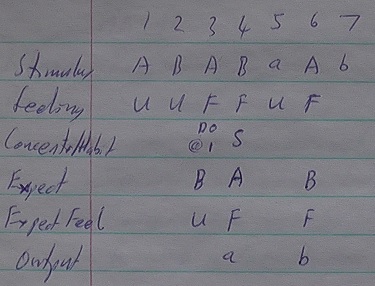
Note: can now output the ‘a’ at 4 because the resulting stimulus of B is also being treated as a triggering stimulus. The recognition habit still gets formed. The outputs are being done because the expected feeling is familiarity. At 6, though we are not repeating to do at 3 in order to ignore the AB pattern. We are finding that the expected B is expected to be familiar and doing an output instead of the habit at 3. At 3 we have successfully proved that if you get an A and do nothing you will get the expected B so no need to do nothing again after the A. But this argument should also apply to 4 where we have not successfully proved that if you get a B and do nothing (such as what happened at 2) you will get an expected A. The A was familiar at 3 but not a successful pair B-A. So correcting the sequence produces:
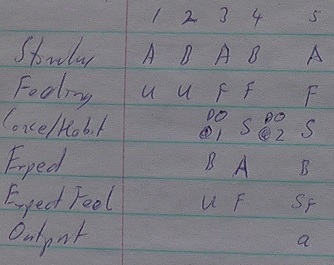
At 4 was successful in repeating the past sequence A, B but it was unsuccessful in producing the expected feeling of unfamiliar. So have no interest in repeating it or having to ignore it. So it’s a successful S-Habit but does not achieve goal which is to avoid familiar and pursue unfamiliar.
More clearly it might be:
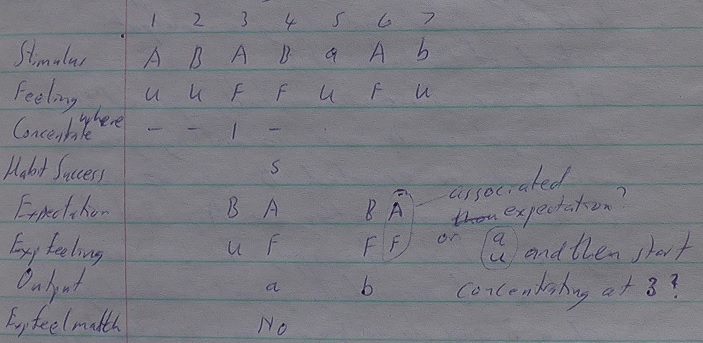
Thinking
Continue to think (process expectations) as long as expectations familiar since finding unfamiliar is the goal!
19th April 1999 R-Habit Practice (From lose note papers)
Playing tennis, see ball coming – decide to do a backhand swing. That is the objective – to get the ball back across the net in left side of court. Perform the backhand habit swing (may need to step to left to do it) include watching ball swinging and follow through. See ball go to left side – feel of accomplishment – success. If see ball go high, hit net, go right, out of court then feel of failure.
Abstractly:
Get A – decide to do A B
a u
objective – get a B – it’s good
So do a – get B – success – feel good
Or get C – failure – feel bad
Or get D – success – feel good
Abstractly with feeling
Get a – decide to do A B
a u
objective get u
so do a – get B failure – feels familiar
get C success – feel unfamiliar
R-Habit
During practice of an R-Habit there is conscious execution of the habit with the introduction of slight variations to the S-Rs as a result of feedback stimuli.
Thinking
There are reflexive thoughts such as next expected stimulus and these can be done in a controlled manner. When do we decide to start thinking (repeating past thoughts)? – i.e. what situation causes thinking to begin?
Concentration
Different concentration levels with different purposes – Is the order correct?
Level 2 - habit not habitualized
Goal is to prove it repeats
1 - repeating habit to achieve goal.
Goal is the idea of result and expected feeling.
0 - not concentrating – unfamiliar
Store it and recall
Familiar – S not habitualized so do it at level 2
- S habitualized and has good goal so do it.
Habits
A failed habit can attract attention! Every time we have a stimulus it results in many LTM matches. Do we do them all if they have been habitualized? LTM matches – some have no response just a next S, some have a response and a next S, position has been habitualized, position not a habit.
S-Habit Context
A recognition only habit (S-Habit) will change contexts as long as it is still recognizable. An R-Habit must receive its expected result to carry on. Surely it can change contexts slightly too to a more appropriate habit path.
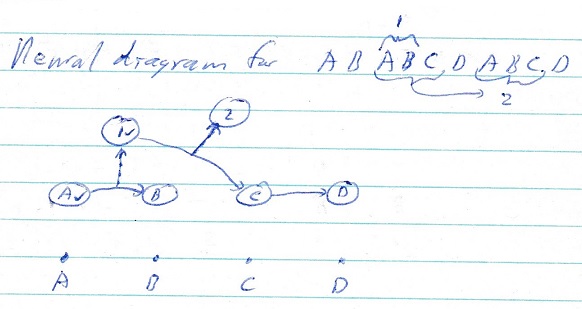
End of lose notes.
21st April 1999 Pain / Pleasure
Pain is continuous until you escape the painful situation. Pleasure is transient even though you stay in pleasurable situation. Evolution has eliminated any organism that stays in the pleasurable situation due to pleasure being continuous.
22nd April 1999
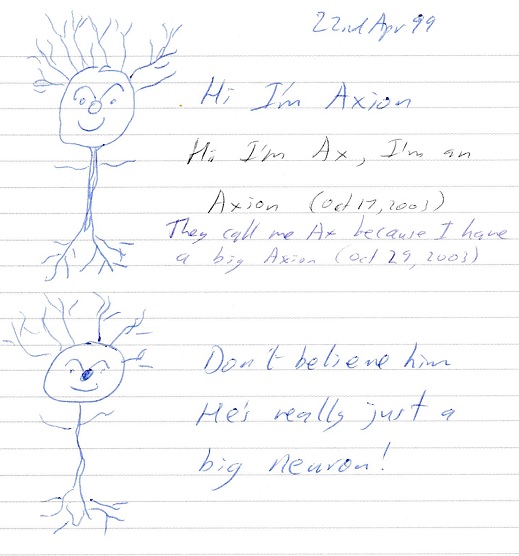
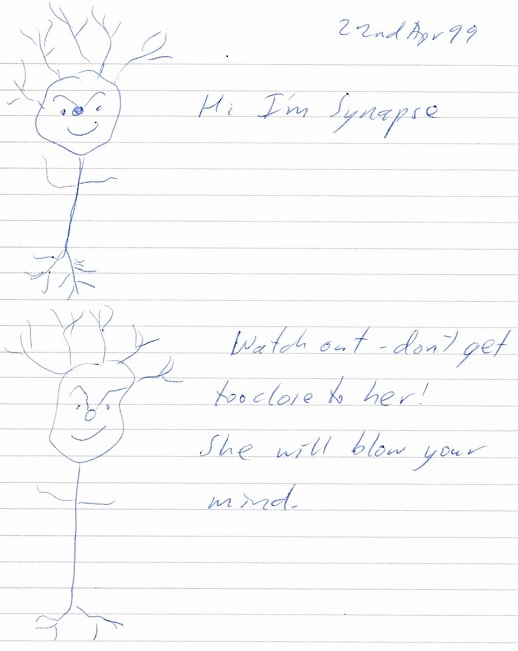
27th April 1999
Need to come up with technique so always seeking novelty / unfamiliar as goal. This might do it.
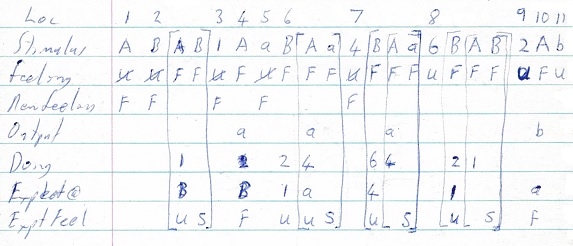
Mark unfamiliar as familiar when habitualized. An unfamiliar result expectation interrupts a habit and starts a new habit @ 6 was going to do @2 but got the A and restarted habit at 4. An unfamiliar result has precedence over recency when beginning a habit.
Several more sequence diagrams on lose sheets.
When all stimuli are familiar then expectations output
At any one time you could have
Several S-habits running subconsciously each with expect F
Several S-habits running subconsciously each with Expect U
Several S-habits running each with expected F
When you expect a goal and its feeling, then get the goal but not the same feeling you feel disappointed.
When you expect a goal and its feeling then get a different goal and the same feeling you are pleasantly surprised.
When you expect a goal and its feeling then get a different goal and not the same feeling you have the opportunity to discriminate – what was different in triggering stimulus?
4th May 1999
While concentrating doing the C-Habit what can interrupt?
1st if C habit has match stimuli then continue it.
If C-Habit fails – stop concentrating
Are any other habits successful? Continue them subconsciously
If any other habit completes and result is familiar add to stimulus list
If any other habit completes and result is unfamiliar – pay attention to it.
Anything with equal or better possibility of reward as that which started the C-Habit.
If Level=0 Stim Famil.
If Expect U – Conc 2
If Expect F – Conc 1 – think until come up with Expt U
Stim is Unf. Conc 0
If level 2
If any successful habit complete, recognize them or done them
Else failed ones – drop – store past Continuing ones – continue
If any Expect U then do them as well.
If level =1
If any successful – complete recognize them or done them
Else – failed ones – drop – store past Continue ones – continue
If any Expect F then do them also.
29th June 1999 loose sheet
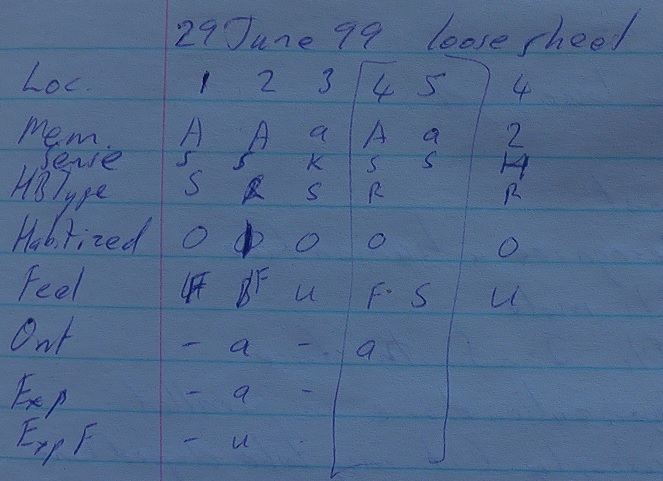
Place expected resulting stimulus and expected feeling with the trigger stimulus for the habit #2.
29th June 1999
How do expectations fit into the process?
Stimulus – recognition only
1st time
Stimulus A unfamiliar
Stimulus B unfamiliar
2nd time
Stimulus A Familiar – expected B – want B – unfamiliar
Stimulus B Familiar – matches expected – success
Do create new Habit?
3rd time
Stimulus A Expect B - Do we want B?
A followed by B implies changing environment.
What about passive environment
1st time
Stimulus A unfamiliar
Stimulus A familiar – Boring do reflex output
Output b input kinaesthetic b
Kin b unfamiliar
Stimulus B unfamiliar
2nd time
Stimulus A – Familiar Expect Stimulus A if do nothing –
Expect Kin b / Stim B if do Output b – expect unfamiliar – good – want -> do
2nd Expect is better one
Output b
Kin b Familiar -> matches expect - > success
Given stimulus A that’s familiar
1st if bored -> reflex output
2nd if do nothing results in unfamiliar stimulus repeat do nothing
3rd find any do something which resulted in unfamiliar stimulus and do it
4th find any do something which resulted in familiar stimulus but not habitualized and prove it by doing it again
5th All do’s proven successful so recall expected stimulus and ask if we got this one would we
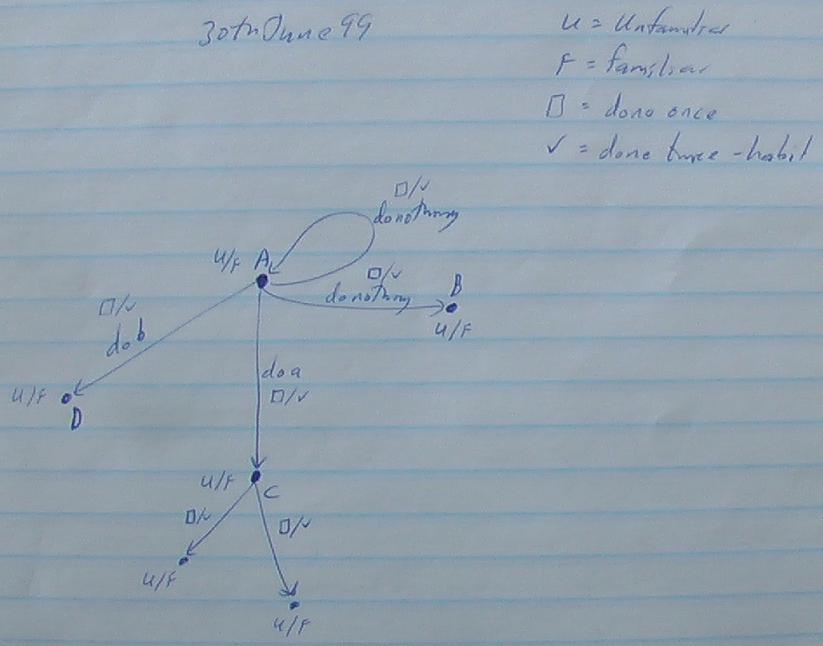
30th June 1999 Notes from loose pages
One Input
- recognize a human face
- it’s male
- it’s Jim Smith’s face
All categorization done in parallel subconsciously (it may take elapsed time to perform)
Do response
If Past Now do it
Unfamiliar Unfamiliar Success
“ Familiar neutral
“ Expected Avoid
Familiar Unfamiliar interest to do again
“ Familiar
“ Expected
Expected Unfamiliar }
“ Familiar } Would not do unless part of achieving a goal.
“ Expected }
30th June 1999 Habits
Habits form hierarchies with stimuli at the leaves. Responses are attached to either stimuli or habits.
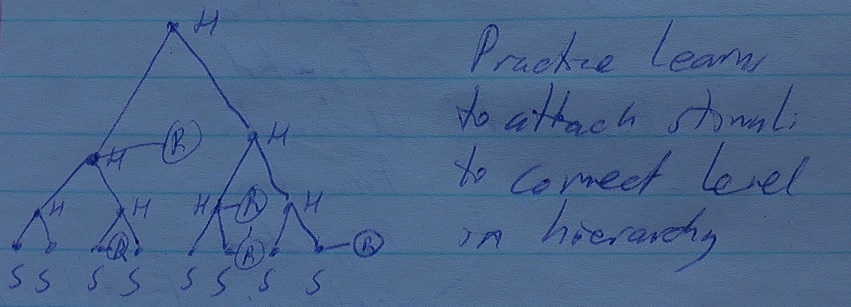
Practice learns to attach stimuli to correct level in hierarchy.
Responses attached to habits indicate more discriminatory stimuli are needed before response is done.
A habit is an R-Habit (of response type) not if it has an attached response but if it is done a response will be performed.
1st July 1999 R-habit Orienting Response
I have this idea that the sub-mind does not subconsciously start any R-Habit without conscious decision to do so. What about orienting responses? Here is a habitualized response that is used to better recognize a stimulus that is done subconsciously – but is it only done as part of a consciously initiated R-Habit?
Concentration
Back in May / June I realized that concentration levels are just a phenomenon i.e. the appearance of the result of selecting stimuli to be conscious of based on the selection criteria. We select to pay attention to stimuli based on the order:
1/ Unfamiliar 1st
2/ Bored – same as last stimulus reflex action
3/ Unfamiliar resulting stimulus expected
Do nothing ones 1st – just recognizing
Do something ones next
4/ Familiar resulting stimulus expected but not habitualized.
Do nothing ones 1st – validate
Do something ones next
5/ All resulting expected stimuli are familiar and habitualized
Either think or try next reflexive response
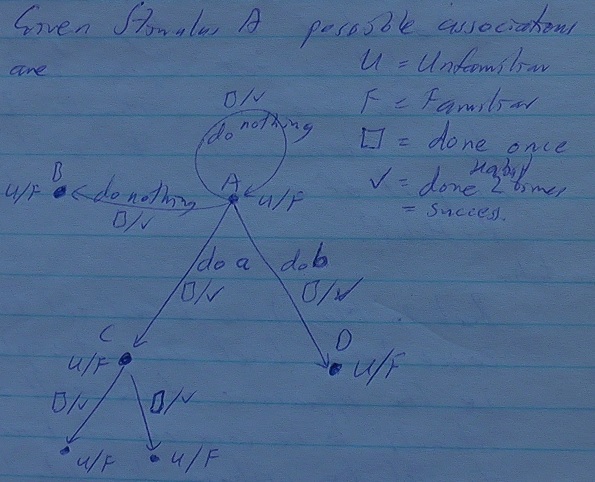
R-Habits
Idea – store R-habits as outputs which get done when stimulus recognized and are successful when resulting stimulus received. Also R-Habits should not be recallable only doable. Thus they should not be stored as stimuli, but they still have to refer to a behaviour sequence which includes recognizing stimuli / S-Habits.
2nd July 1999 R-Habits
So a 'Response – S-Habit – Response' (R-S-R) is collapsed into an R-Habit when the second response is followed by the stimulus that matches expected one and you get the feeling of success provided the sequence is practiced consciously.
4th July 1999 Expectations, Feelings
Examples of backwards propagation of Expected Feelings (EF) through series of Stimuli (s) and Responses (R)
S EF R S Feeling
1st Food -> Neutral -> Eat -> Taste -> Good
S EF R S F
2nd Food -> Good -> Eat -> Taste -> Good
Let’s assume the feeling obtained from the food becomes neutral after some time. Actually what happens is the food no longer decreases the hunger and the pain of a stretched stomach increases.
S EF R S F
3rd Food -> Good -> Eat -> Taste -> Neutral
S EF R S F
4th Food -> Neutral -> Eat -> Taste -> Neutral
S EF
5th Food -> Neutral don’t do eat; try something else as a response.
What if get a bad taste from food?
S EF R S F
3rd Food -> Good Eat Taste Bad
S EF
4th Food -> Bad don’t do eat.
A neutral stimulus like money can become a desired one by association with food.
S EF R S EF R
3rd Money -> Neutral -> Buy -> Food -> Good -> Eat etc.
S EF R S EF R
4th Money -> Good -> Buy -> Food -> Good -> Eat etc.
Similarly expected neutral and bad can propagate backwards one S-R-S each time it’s done.
Recognizing Stimuli – Read Pg 28 + 29 (Oct 5th 1998)
Stimulus pairs collapse to form S-Habits when they are recognized successfully. But have a problem with the following:
1 2 3 7 8 then 11 12 13 15 16
A B C … 1 C … X B D … 11 D 1 = [A B] and 11 = [X B]
Now what do we recognize when we get ABD?
Do we recognize 1D or A 12 or ABD? The AB not collapsed because B has more than 1 expectation? If that were true then we would not have got the 11 at location 15.
5th July 1999
The A 12 is the answer – after A B we should have a 1 habit and a B expecting a D with the context of an A. The D causes the 1 habit to fail but the B expecting a D succeeds and produces a 12.
What about a D E sequence in the middle of a series ABCDEFGH when DE has also been received elsewhere. The DE will start a recognizing habit but fail on the F – the oldest habit then continues and recognizes ABCDEFGH.
10th Aug 1999 Moods
From Pg 9 (July 5th, 1998) – moods are Happy, Sad, Bored, Interested and Neutral. Feelings that cause change of mood are Good, Bad, Novel, Familiar and None (when any of these feelings stop).
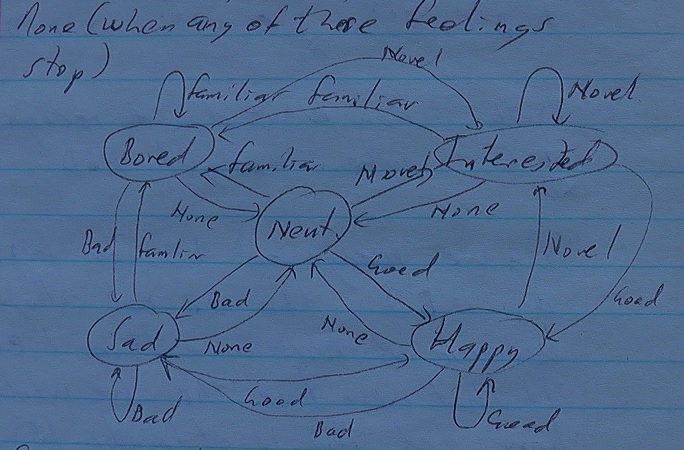
So the state / mood you are in depends on the last feeling – Is there any value in having moods?
R-habits R-S-R pg 54-55 (1st & 2nd July 1999)
The idea of R-S-R producing an R-Habit is similar to idea on Pg 17 (9th July 1998). An S-Habit only contains stimuli with no responses between them. An R-habit contains an S or S-Habit with in it but only if the S (-habit) is atomic – i.e. recognizable as a single stimulus.
Timing Pg 22, 23, 28 (28th Aug, 1st Sept, 5th Oct 1998)
Timing is a new stimulus from the comparison of input events. Human senses can also produce relative stimuli such as above, below, beside, bigger, smaller, taller, shorter, colder, hotter, sharper, rougher, smoother, brighter, softer, louder, higher pitch, closer, deeper, faster, and sweeter – and the list goes on. This works for any sense in which the dimensions form a continuum with some form of scale that allows for comparisons. Note on Pg 20 (28th Aug 1998) generalization / Specialization these relative stimuli are also included in the set of innate produced stimuli.
Context
Bottom Pg 20 (28th Aug 1998) we talk about context. The habit of recognizing on pg 57 – 5th July 99 requires a context piece which was recognized up to the point at which there was a switch from doing one habit to doing another!
R-Habit
What is involved in learning an R-Habit?
1st, It must be conscious from triggering stimulus St through to resulting stimulus Sr and the feeling of success. Bottom of Pg 41 (April 16th, 1999)
2nd, In between St and Sr we must do an R,S,R sequence where R,S,R are all either lowest level S’s and R’s or are S-habits or R-Habits. So a sequence such as St R1 S1 S2 R2 Sr can not collapse to St, R-habit, Sr until S1 S2 are recognized as a single S-habit. Often the S1 is a kinaesthetic stimulus. The S1 S2 become Si (I =intermediate). When St occurs and have a past experience St R1 Si R2 Sr and consciously do it all then the R1 Si R2 collapses into Rn (n=new) and have St Rn Sr stored in memory. The event that triggers the collapse is the Sr matching the Expected Sr which was thought about when St occurred. Why wasn’t Si thought about? Maybe Sr was the desired goal (rewarded) and we were currently in the St context – situation and the sequence R1 Si R2 was the way to achieve the goal.
12th Aug 1999 R-habits
Expectations are critically important in getting this R-Habit hierarchy to form. When St occurs we should get an expectation of Si and its associated feeling expectation. If the expected feeling is good or bad we will do it or avoid it. But if it is neutral then the expected Si should match all other Si’s that have been experienced and their expected Sr’s to be recalled with associated expected feelings. If any of these are good then they / it becomes our goal. We then do the R1 and if all goes well get the Si and no feeling of good or bad but we now continue (concentrating / practicing) with the R2 and if all goes well get the Sr which matches our goal and thus the feeling of success and R1 Si R2 Rn.
Starting at the beginning again – when St occurs we get the expected Si if its expected feeling is good then it would be natural to do the R1 and get (hopefully) the Si. If Si’s expected feeling is bad then we would not do the R1. If there is no expected feeling we can continue thinking and the next associated expected S is Sr which if it has no associated feeling becomes another thought with no associated action done. But if it has an expected good feeling then we start doing the R1 response. Sr is our goal with associated expected good feeling. We then get Si. This should produce the same recollections as when it was thought about after St because experience has not changed. So we would naturally do R2 because Sr was previously rewarded – Note even if Sr only had an expected feeling of good this should also work.
Expectations
This leads into expectations of Stimuli and expectations of feelings. Can a stimulus have an expectation of a feeling as well as an actual feeling or is it only expectations of stimuli that have the expected feelings? Most stimuli have no feelings of good or bad and after they have been experienced once they are always familiar. When a stimulus invokes a good or bad feeling it should do this consistently but most stimuli are neutral on the good / bad scale.
